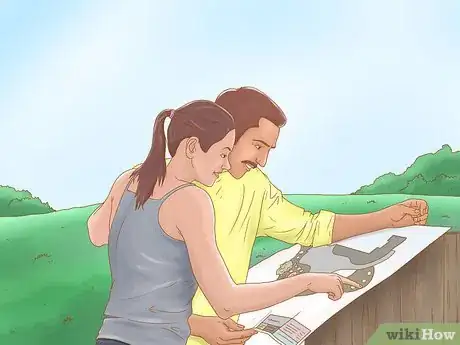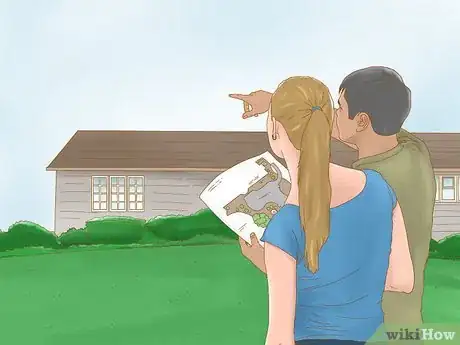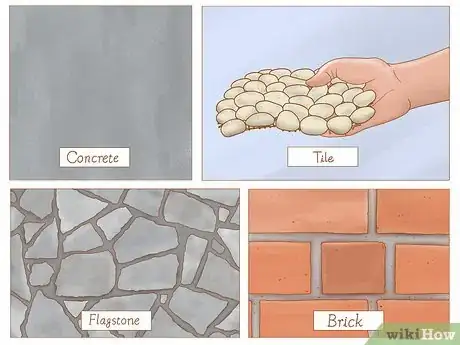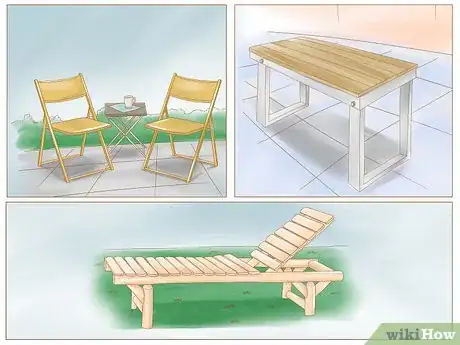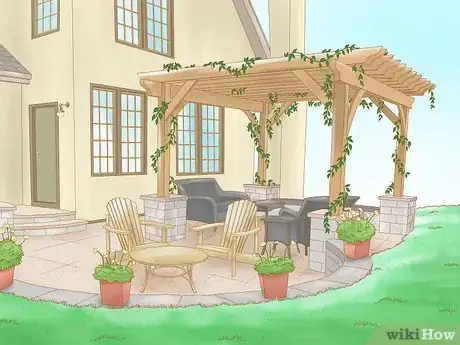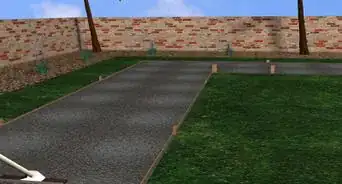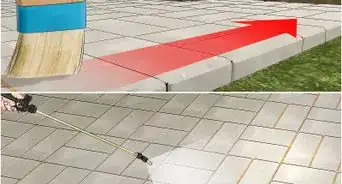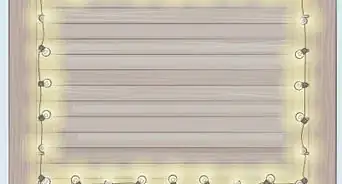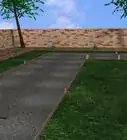This article was co-authored by Alberto DeJesus. Alberto DeJesus is a Construction Specialist and the CEO of DeJesus Industries. With more than four years of experience, he specializes in high-end real estate development and construction. Alberto and DeJesus Industries have been featured on NBC News and have worked with numerous well-known companies, including Mazda, Amazon, and CVS. Alberto holds a Bachelor’s degree from Boston University.
There are 9 references cited in this article, which can be found at the bottom of the page.
This article has been viewed 39,860 times.
Creating an outdoor living area is a fun and lasting way to customize your home. An outdoor patio can complement your property with additional entertainment, dining, and seating areas. However, designing a comfortable and beautiful space does not necessarily require a professional. Keeping a few considerations in mind, planning your own patio space is easier than you might think.
Steps
Assessing the Space
-
1Research the rules and permissions needed for building a patio. Different cities and in the United States require different permissions for adding on to your home.
- If you rent your home, you must ask permission from your landlord if you wish to add anything onto the property.
- Visit your city’s official website for a list of permits needed to build a patio on your property.
- If you belong to a Homeowners Association, you may have to lobby for permission to build your patio. Contact your HOA to find out about the permissions they require for building in order to avoid fines.[1]
-
2Decide how you will use the patio. Choosing what you’ll use your patio for is the first step in creating a dynamic and complementary outdoor space.
- Maybe you want a space for parties, or maybe you simply want a private place to sit and people-watch.
- Most patios are built for a mixture of personal and social uses, so you might want to design with a versatile patio in mind.
Advertisement -
3Choose the location of your space. Designing a patio that’s close to your kitchen is best if you plan to do any entertaining.[2]
- Building a patio close to your kitchen is advisable for easy access to the house and to refreshments.
- Quick kitchen access is also important if you are thinking of using the space for a lot of dining.[3]
-
4Size the space and draw a plan. Sizing and measuring the space is key to understanding what you have and what you can do with it.
- Knowing the size of the space and how many people it will accommodate is essential. You can do a dimensioned drawing of the space, or simply mark the outlines of the space with chalk to visually plan how much space you have to work with.[4]
- There is no set rule about how large or small your patio should be. One expert suggests that a patio with a fire pit surrounded by 4 or 5 chairs should at least be fourteen feet in diameter.[5]
- If you have the space for it, a good rule of thumb is to build your patio proportionately to your house - make it as long as your house is tall, and as wide as your house’s length.
- A simple way to get a general view of the space is to place chairs and tables around the lawn where you would like them to be on your patio.[6]
Choosing the Materials
-
1Think about what materials you want to use. For the patio itself, you can use concrete, tile, brick, flagstone, tile, or pavers.[7]
- These materials all come in many colors and can be customized to fit your needs. Visit your local hardware store for styles and pricing.
- If you want tables and chairs for the space, be sure to choose a material that won’t cause the furniture to wobble. Go with concrete, tile, or any consistently flat material if you want to minimize furniture wobbling.
- If you are on a tight budget, gravel is the cheapest option and easiest to install.
-
2Be aware of your budget. Certain materials cost more than others, while some are cheaper but will take more time to install.
-
3Decide whether you want to hire someone to lay your patio or if you want to do it yourself. If you plan on pouring concrete or laying a more complex foundation, you might want to hire a professional.[10]
- Some materials, like certain tiles, bricks, and Pavers can be installed without hiring a professional. Keep in mind, however, that you will need to level the ground first.
- Most cities have professional, local patio builders. Do some research and call different businesses to get estimates and find out if this is the option for you.
-
4Consider waterproofing your patio. Inclement weather is inevitable, and your patio will likely come into contact with rain at some point.
- There are several products on the market specifically made to waterproof your patio. The product you use will largely depend on the materials you are using to build.
- A concrete patio can often be easily waterproofed by a beginner using one product.[11]
- A stone patio may need to be sealed and then waterproofed, and may require more time and experience.
- There are several products on the market specifically made to waterproof your patio. The product you use will largely depend on the materials you are using to build.
Adding Landscape and Furnishings
-
1Plan if and where you want plants and landscaping. Greenery can be aesthetically pleasing, and it can also offer shade and privacy.
- If you are unsure about what plant life you want, you can simply lay the patio foundation first to see what you’re working with. You can always add greenery later if you choose to do so.[12]
- Think about whether you have a green thumb or prefer plants that don’t need as much care. Being honest about your ability to manage plants will help you know which ones and how many to buy.[13]
-
2Consider the furniture and accessories you want to add. Picking versatile, affordable, and durable furniture will help you create a dynamic and custom space.
- Look for a great set of patio furniture that will be sustainable and affordable. Buy or borrow a stack of interior design magazines to get a feel for the different approaches to design that home accessories companies provide.
- Most hardware stores have many different styles of patio furniture available. Visit various stores to see what types of furniture are available to help you decide what you do and don't want.
Advertisement -
3Pay attention to whether your patio will be in a shady part of your yard or a sunny one. Depending on how the sun hits your space, you may want an umbrella, gazebo, or awning.
- Plants can also be a good source of shade. You can plant trees or shrubbery to help block the sun.
-
4Think about the usage of the space. Choosing the right furniture depends largely on how you plan to utilize your space.
- If your patio will be used as a private outdoor area for you and your family, perhaps a few chairs, ottomans and side tables will do the trick. However, if you image lavish garden parties and elegant patio affairs, large-scale seating as well as table surfaces may be best.
Community Q&A
-
QuestionWhat is the cheapest type of patio to build?
 Matt DalyMatt Daly is a Landscape Designer and the Founder of Water & Earth Landscape Design, which is based in both Richmond, Virginia, and San Jose, California. With nearly 10 years of experience, he specializes in designing outdoor living spaces, including patios, pools, and fireplaces. Matt also runs a blog where he educates homeowners about landscaping topics: https://www.liveinyourbackyard.com/. He earned his Landscape Design & Horticulture Certification from The University of Richmond, where he also studied Sustainable Landscape Practices.
Matt DalyMatt Daly is a Landscape Designer and the Founder of Water & Earth Landscape Design, which is based in both Richmond, Virginia, and San Jose, California. With nearly 10 years of experience, he specializes in designing outdoor living spaces, including patios, pools, and fireplaces. Matt also runs a blog where he educates homeowners about landscaping topics: https://www.liveinyourbackyard.com/. He earned his Landscape Design & Horticulture Certification from The University of Richmond, where he also studied Sustainable Landscape Practices.
Landscape Designer A gravel patio, definitely—just make sure that you're using jagged gravel rather than pea gravel. Jagged gravel will lock in place, so you'll be walking on top of the gravel rather than through it. Best of all, you can easily maintain your gravel patio by just adding more gravel to it!
A gravel patio, definitely—just make sure that you're using jagged gravel rather than pea gravel. Jagged gravel will lock in place, so you'll be walking on top of the gravel rather than through it. Best of all, you can easily maintain your gravel patio by just adding more gravel to it!
References
- ↑ http://www.houselogic.com/home-advice/home-thoughts/hoas-what-you-need-to-know-about-rules/
- ↑ https://www.bobvila.com/articles/patio-building/#.VqepofkrLIU
- ↑ http://www.bhg.com/home-improvement/patio/patio-planning-step-by-step/#page=2
- ↑ http://www.landscapingnetwork.com/patios/planning.html
- ↑ http://www.hgtv.com/design/outdoor-design/outdoor-spaces/patio-planning-101
- ↑ http://www.bhg.com/home-improvement/patio/patio-planning-step-by-step/#page=3
- ↑ https://www.bobvila.com/articles/patio-building/#.VqepofkrLIU
- ↑ https://www.bobvila.com/articles/patio-building/#.VqfSy_krLIV
- ↑ http://www.hgtv.com/design/outdoor-design/outdoor-spaces/patio-planning-101
- ↑ http://www.bhg.com/home-improvement/patio/patio-planning-step-by-step/#page=6
- ↑ http://www.valsparpaint.com/en/how-to/concrete/enhance-beauty-of-stone.html
- ↑ http://www.hgtv.com/design/outdoor-design/outdoor-spaces/patio-planning-101
- ↑ http://www.hgtv.com/design/outdoor-design/outdoor-spaces/patio-planning-101
About This Article
To design a patio, plan on making it about as long as your house is tall and as wide as your house's length. Also, choose a location near the kitchen if you plan to use it for entertaining or dining. Then, pick a smooth material like concrete or tile if you plan on having tables and chairs since this will prevent them from wobbling. Once you decide on the bigger picture, then you can add accessories, like awnings and umbrellas if your patio is in the sunny part of your yard. To learn how to waterproof your patio, keep reading.

